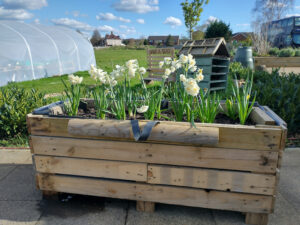
Step 1 – Think before growing
Whether this is your first attempt at creating a vegetable garden or if you’re a pro, it is always best to think about what vegetables you want to grow beforehand. If a vegetable patch is new to you we would definitely recommend starting with a vegetable that is easier to manage.
Step 2 – Choosing where to grow
As with most things in the garden, heaps of sunshine will do wonders for your vegetable patch, so it is best to find a spot that provides at least 5 hours of sunshine a day. Vegetable growth is rapid, so plenty of sun to fuel this process is beneficial plus extra sun will add extra flavour to vegetables. Therefore, if your garden allows, try to avoid overhanging trees and shade throwing sheds and buildings. If you do decide to plant vegetables that on occasion need shade, such as some salads or strawberries, it is recommended to use netting. When thinking about where to create your vegetable garden, it is also good to think about what you don’t wish to attract i.e. slugs. It is best to not place your patch next to any bushes, long grass or thick flower borders, as this will attract them to your crops.
Step 3 – Adding soil
Before improving the soil it is best to dig over your vegetable patch to help break up the existing soil and remove any weeds, roots and stones. Adding in lots of compost will massively improve any soil and we would recommend our Cow Compost that is a fine graded compost, with rich nutrients encouraging healthy high yielding crops. An extra benefit is that our Cow Compost is produced from our own organic dairy farm, helping to add to that organic factor! Having good soil will have a big influence on growing your vegetables and different types of soils will work differently. For example if the soil is of high clay content, it will take longer to warm up in spring, but will need little watering when growing later crops; whereas a light, airy soil will be more workable in early spring. However, if you don’t wish to work with the nature of your soil, building a raised bed will be recommended to help extend your growing season.
Step 4 – Prevention of weeds
Ideally before planting your vegetables and adding in soil, all weeds should have been removed. However, we do understand that weeds can regrow and annual ones can cause a problem. If this is the case for your garden it is recommended to cover the vegetable patch with clear plastic prior to spring for a couple of weeks, allowing the soil to get warm and boost the development of any dormant weed seeds. When you go to plant your vegetables, these weeds will then be easy to remove, enabling you to have a weed free vegetable garden. If you wish for extra help to prevent any weeds from reappearing, spreading a thin layer of Compost Mulch will do the trick as it is a nutrient rich weed suppressor.
Step 5 – Get growing
Once the area and the ground have been prepared for your vegetable garden then you are able to get growing! It is worth remembering that not everything has to be planted outside and some plants, such as Basil will be fine growing in pots.
Growing your own vegetables is an enjoyable experience and it’s great that in doing so they will taste even better!



